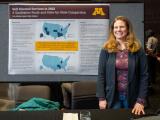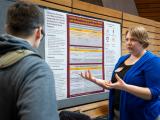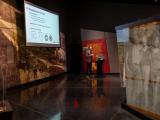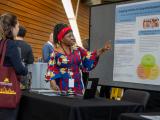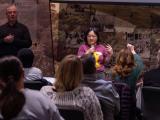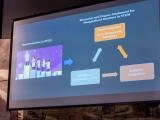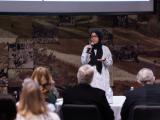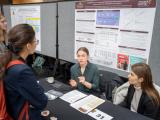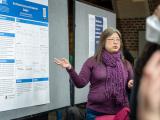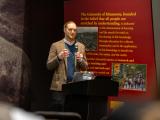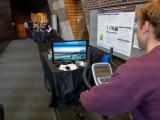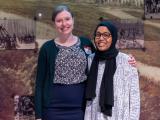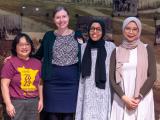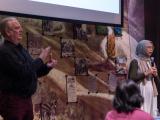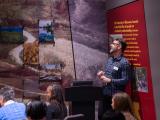CEHD Research & Innovation Day
CEHD Research & Innovation Day showcases the impact of college research on our lives. This open house-style event features poster presentations from select students and faculty in the College of Education and Human Development.
CEHD Research & Innovation Day will be held on Thursday, March 26, 2026.
Research Day posters from previous years are available in the UMN Data Conservancy.
Photos by Jairus Davis.
Posters featured at the 2025 LEAD Conference
GenAI Chatbots and Language Learning: Emerging Affordances
Author(s): Luis Lopez, Galyna Arabadzhy
Despite the shortcomings of earlier chatbots such as their inability to produce sophisticated dialogue and the use of limited pre-set knowledge bases, chatbots as language learning tools have been used extensively for more than two decades. Previous studies outlined technological, pedagogical, and social affordances of chatbots for language learning settings. The latest advances in the field of computer assisted language learning (CALL), however, signaled a change across the educational field. In other words, GenAI models that became available to the public in 2022 addressed the shortcomings of earlier chatbots which prompted a more frequent use of chatbots in language classrooms.
Adhering to Kirschner et al.’s (2004) usefulness framework and its extension conducted by Huang, Hew, & Fryer’s (2021), this systematic review traced the emergence of new affordances within the existing categories (technological, pedagogical, and social) that were brought into language learning due to educators utilizing GenAI-powered chatbots in classroom instruction. Specifically, one technological/pedagogical affordance (Sequential Workflow) and two pedagogical affordances (Exploration and Translanguaging) were identified as new affordances within the existing framework.
Enabling Professional Growth and Identity of High School Computer Science Teachers through One-on-One Coaching
Author(s): Jennifer Rosato, Fatima Brunson, Laycee Thigpen, Joe Tise, Monica McGill
We designed a one-year coaching program to provide U.S. high school CS teachers with the ongoing support to help shape their professional growth and identity as CS teachers. Our research question for this project was: Does CS coaching facilitate teacher professional growth and identity as a CS teacher? Adopting a mixed-methods approach, our study leveraged pre- and post-program surveys, ongoing coaching logs, and introspective self-reflection checklists to triangulate data from both coaches and coachees. Coachees' rated their professional growth and identity significantly higher after the intervention compared to before, and this difference indicated a large effect. Both before and after intervention, coachees indicated they identified partially as CS teachers, and this sense of identity grew after intervention. The success of this pilot, rooted in effective professional development practices, demonstrates how engaging teachers in coaching can motivate their interest in teaching CS. Professional development providers and regional agencies can replicate and adapt these processes to empower new CS educators.
Pilot to Progress: Expanding the Mental Health Ambassador Program for Youth Statewide
Author(s): Briana Joseph, Chandima Herath Mudiyanselage, Grace Gebler, Cante Nakanishi, Yunqi He, Eric Pothen, Rica Rivera, Lindsey Weiler
According to the CDC (2023), many youth in the United States experience mental health challenges, with estimates as high as 44%. In Minnesota, 29% of students reported long-term mental health problems, continuing an upward trend (MN Student Survey, 2023). Mental health care systems could benefit from trained youth and adult community members providing low-intensity support and referrals as part of a stepped care approach. To address this need, MENTOR Minnesota and the University of Minnesota partnered to create the Mental Health Ambassador (MHA) Program. This training program equips community members in mentoring programs with skills in community resources, appropriate referrals, Youth Mental Health First Aid, and suicide prevention. The pilot cohort of 17 youth and adults completed training and an advocacy project, leading to key program changes, including curriculum revisions, adding a full-time staff member, and an extra in-person advocacy session.
Building on this success, the program aims to expand to 50% of counties in Minnesota by 2028, including an Indigenous Mental Health Ambassadors program to address community-specific needs. This 8-session initiative empowers youth and mentors to support youth mental health, with ongoing research assessing program effectiveness and impact.
Culturally relevant pedagogy training for special educators: A systematic review
Author(s): Lalinne Suon Bell, M. Y. Savana Bak, Kamola A Salimova, Betsy Moore
This systematic literature review investigated culturally relevant pedagogy training for educators of students with disabilities. The purpose was to examine existing training practices, summarize key elements used in training special educators, highlighting gaps in integrating cultural identities and disability. The study questioned whether current training sufficiently incorporates culturally relevant pedagogy principles addressing the complex intersectionality of culture and disability. The review followed PRISMA guidelines (Moher et al., 2015). A Boolean search of relevant databases was conducted using inclusion and exclusion criteria to identify pertinent literature. Articles meeting these criteria were analyzed using a quality checklist to evaluate how training incorporated core values of culturally relevant pedagogy. Results reveal that few systematic training programs are available, and many initiatives lack a structured approach emphasizing reflective teaching, theoretical grounding, and dialogue on race and social justice. Key components of culturally relevant pedagogy include recognizing diverse cultural backgrounds, engaging in reflective practices, and integrating them into individualized education plans to enhance student engagement, achievement, and social‐emotional outcomes. Overall, the findings emphasize the need to enhance culturally relevant pedagogy training for special educators. The review provides actionable insights and recommendations to reform teacher training programs so that special education meets all students’ diverse needs.
NumberShire: Research and Development of an Evidence-based Educational Game for Students with Learning Disabilities in Mathematics
Author(s): Sam Choo, Jechun An, Reagan Mergen
Educational technology (EdTech), like educational games, has great potential to enhance learning outcomes; yet, guidelines for educational game development remain meager causing confusion among game developers and consumers. The overarching goal of this presentation is to address the needs of developing and establishing extensive guidelines for developers and consumers of educational games to follow when developing or purchasing and implementing game-based learning and interventions. In this presentation, we will describe the results from our recent study conducting a content analysis with a successful example of an evidence-based mathematics gaming intervention, called NumberShire, funded by a series of federal grants to offer insights to EdTech developers and consumers. NumberShire is an educational mathematics gaming intervention designed to build a strong foundation of whole number concepts and skills for early elementary students, specifically those with or at risk for learning disabilities in mathematics. NumberShire was iteratively developed and validated through 7 federally funded projects. The research and development (R&D) process underscores the importance of a cycle of improvement with repeated proposing, prototyping, user and field testing, and revising the game. As well, the theory-based logic model and collaborative effort with multidisciplinary experts were key components of the R&D process.
Empowered Generations Program Can Lead to a Decrease in Child Behavior Issues
Author(s): Chris Mehus, Jaime Ballard, Xavier Greene, Janette Driscoll, Chansophal Mak, Ana Mireya Díaz
Parenting programs effectively prevent behavioral health problems such as depression and conduct disorders. Unfortunately, parenting programs are not widely available nor well-attended; programs are often lengthy and in-person, so parents face barriers needing to find transportation and childcare.
We aim to prevent significant behavioral health problems through widespread access to accessible, effective parenting problems. In this study, we pilot-tested a brief, online parenting program, Empowered Generations (eGen). Empowered Generations is based on GenerationPMTO, an evidence-based program that helps strengthen the connection between parent and child. The counselor empowers the parents to learn new skills that encourage positive behavior, and the parents in turn can empower their children.
Parents (n = 42) were randomly assigned to either the eGen program or an education session, and took surveys both before and after. Parents in the eGen program saw an average 20% reduction in overall behavior problems, while parents in the control group saw no change (Hedges g = -.38). Parents were also invited to participate in focus groups, and commented on program acceptability and feasibility. Due to this early promising evidence, the eGen program is currently expanding statewide and with a randomized controlled trial of effectiveness underway.
Patterns in Unstructured Outdoor Family Play
Author(s): Alex Ho, David DeLiema
In open-ended play-based settings, children propose, adopt, and negotiate different roles and rules as their play progresses, experiencing the process of leading activities by creating the structures of their play. We extended this prior work by studying naturalistic, outdoor family play through detailed analyses of video. Families with children 2-4, who participated in Free Forest School gatherings, recorded and shared videos of their play. We utilized interaction analysis to create a coding framework for capturing their play and moment-to-moment negotiations over roles and rules. We then created transcripts of focal moments that capture participants’ body language and verbal expressions. Preliminary findings suggest that children are the prime leaders when playing. Children constantly come up with new ideas, create variations on activities, establish play patterns, and negotiate changing roles and rules. This study emphasizes the significance of unstructured play in developing leadership, interpersonal, and creative skills for educators, researchers, and parents.
The Effects of Read-Aloud of a Refutational Text and Visual Aid on Young learners’ Knowledge Revision on a Science Topic
Author(s): YooJeong Son, HyeJin Hwang, Kristin Burger, Panayiota Kendeou, Jackie Relyea
Having misconceptions about science topics can hinder further development of science content knowledge. One way to address students’ misconceptions is using refutational texts that explicitly state a common misconception, refute it, and provide the correct scientific explanation. In this study, we examined the effects of read-alouds of a refutational text and visual aid on knowledge revision in a science topic (birds) using pre-, post-, and delayed- test experimental design. Each of kindergarten and first-grade students(n=83) in six classes was randomly assigned to a Standard-information-text with Standard-visual-aid condition (SS condition; n=28), a Refutational-text-with-Standard-visual-aid condition (RS condition; n=28) and a Refutational-text-with-Refutational-visual-aid condition (RR condition; n=27). The preliminary finding demonstrated an effect size of .2 that favors the refutational-text condition (RS+RR), indicating that the refutational-text group students tended to perform better than the other. Specifically, greater effect size was observed between the RS and SS conditions (ES=.29, favoring RS), compared to the effect size between the RR and SS conditions (ES=.17, favoring RR). The effect size comparing the refutational text and standard text conditions at delayed-post test decreased to .10, favoring the refutational condition. Overall, the findings suggest the potential of a refutational text in supporting young students’ knowledge revision.
2025 Research & Innovation Day posters
Autism Spectrum Disorder Prevalence in Immigrant Communities in Minnesota: Data from the MN-ADDM Study
Author(s): Jennifer Hall-Lande, Amy Esler, Libby Hallas, Ruby Nguyen, Yi-Chen Wu, Ryan Ferguson, Krista Stokes, Chris Rogers, Lexi Koller
Presents results from the CDC-funded Minnesota-Autism and Developmental Disabilities Monitoring Network (MN-ADDM) project. MN-ADDM monitors the prevalence of autism spectrum disorder (ASD) in children aged4 and 8 within portions of Anoka, Hennepin, and Ramsey counties in Minnesota. In addition to race and ethnicity categories routinely studied by the CDC, MN-ADDM estimates prevalence among Somali and Hmong immigrant populations. Early identification can improve outcomes for children with ASD, so understanding pathways to identification in communities informs public health policy in the hopes of better serving children in all Minnesota communities.
Displaced Children Experiences: Lessons learnt from the Atyrau Kids University
Author(s): Aigul Sultangubiyeva, Aigerim Shilibekova, Lyailya Koishigulova, Akmaral Mukhanbetzhanova, Zhanylsyn Sabirova, Gulshat Shugayeva
The REACH project at Atyrau Kids University is a unique experience that shaped a model for building a learning space and program for Displaced Children with Disabilities. The research is based on the participatory methodology, including the children, their parents, teachers, volunteers, counsellors, nonprofit experts and university managers. It was the year 2019 when a special humanitarian operation called ""Zhusan"" was initiated by the government of Kazakhstan that repatriated 600 people, including 413 children. 7 families with 25 children were located in the Atyrau region. In this specific context, Atyrau University has played a vital and pioneering role as it was the starting point to engage those children.
The research aims to describe a unique experience of learning about children who were repatriated to their home country after living in a war-torn Syria and to share the model implemented at KidsU. The single case study can provide insights into the needs of displaced children with disabilities and strategies to address those needs.
How Can Professional Development Promote Equitable Practice?
Author(s): Alyssa Meuwissen and Deb Ingram
This poster shares the results of a literature review around professional development designed to promote equitable practices for early childhood and education professionals. We first reviewed the models of professional development that are commonly used, identifying key characteristics of each. We then examined what commonalities exist across models and where there is agreement on the necessary ingredients for effective professional development on equity. Finally, we made a crosswalk of professional development modes with the levels of racism they can address, using the Iruka et al. (2021) model. Implications of the work include informing those who choose professional development around equity for staff about indicators of quality professional development and important dimensions to consider for best fit. The literature review included academic publications, reports, and reviews of website content. This work was funded by the Annie E. Casey Foundation. View the poster
"I wanted a better life”: Higher education aspirations and agency of Kazakhstani youth from lower socioeconomic backgrounds "
Author(s): Amankulova, Zhuldyz
Although a large body of literature explored the mechanisms that shape social mobility of youth, it remains unclear how youth, especially from marginalized backgrounds, exercise agency in pursuing aspirations. Drawing on life history narratives of prestigious university graduates from lower socioeconomic backgrounds in Kazakhstan, this study examines challenges that the graduates faced in pursuing aspirations for higher education and how they exercised agency within these constraining conditions. This research makes significant contributions to the literature on youth aspirations, agency, and Bourdieu’s theory of field while highlighting circumstances that improve higher education access of youth from marginalized backgrounds.
Factors Influencing Rehabilitation Practitioners’ Recommendations of Social Support Strategies for Post-Stroke Physical Activity Engagement
Author(s): Amos Badu, Joy Erlandson, Karli Jahnke, Elena Donoso Brown, Emily Kringle
Background: Social support enhances post-stroke physical activity (PA), yet rehabilitation practitioners do not consistently make this recommendation. Facilitators of implementing social support recommendations for post-stroke PA are unclear.
Methods: Data were collected using an online cross-sectional survey of US-licensed rehabilitation practitioners. Descriptive statistics and chi-square tests were used to characterize facilitators of implementing social support recommendations for post-stroke PA and to explore differences based on practitioners' roles and practice settings.
Results: Rehabilitation practitioners (N=542; occupational therapy: n=247, 45.6%; physical therapy: n=295, 54.4%) who practiced in outpatient clinics (32.8%), skilled nursing facilities (17.0%), acute care (22.7%), and acute rehabilitation (14.9%) participated. The most common facilitators were the presence and willingness of other people in patients’ lives, practitioners’ scope of practice, and practitioners’ role on the rehabilitation team. The least common facilitators were knowledge of and access to social support assessments, interventions, and community resources. There were differences in perceptions of scope of practice and knowledge of social support assessments and intervention based on practitioner roles and practice settings (p<.05).
Conclusions: Training on social support assessments, interventions, community resources may support the implementation of social support for post-stroke PA. Future research should explore rehabilitation practitioners’ decision-making related to social support.
An Implementation Study of Positive Recovery Journaling: An Intervention to Improve Alcohol and Substance Use Disorder Treatment Outcomes
Author(s): A. Krentzman, S. Harris, M. Choy-Brown, E. Bowen, S. Zemore
Positive Recovery Journaling (PRJ), a therapeutic intervention to treat addiction, has shown beneficial impact on well-being. The purpose of the current study was to investigate the correlates of PRJ implementation in real-world settings.
We trained 37 counselors in 6 countries (US, Canada, Romania, Singapore, South Africa, UK) to use PRJ with their clients in eight manualized sessions.
After an 4.5-hour training, 33 counselors (89%) agreed to use PRJ with their clients for 8 sessions; 23 (70%) used PRJ at least once, and 19 (58%) completed all 8 sessions. Intentions to use PRJ post-training (p = .024) and using expert consultation (p < .001) were associated with using PRJ at least once. Female gender (p = .021), participating in expert consultation (p = .001), and implementing PRJ with groups (p = .016) were associated with using PRJ all 8 times.
Results emphasize the usefulness of expert consultation, high-quality trainings, and using PRJ in groups. PRJ might be equally viable in diverse settings and with training delivered in-person or virtually.
Access to Alcohol Use Disorder Treatment Among Women: An Empirical Examination of Health Service Utilization
Author(s): Bonnie Horgos
Alcohol use disorder (AUD) is a major public health concern for women, yet treatment utilization remains low, and few models adequately explain women’s enrollment in AUD treatment. This study evaluates Andersen’s Behavioral Model of Health Service Use (Andersen’s Model) as a framework for understanding AUD treatment enrollment and tests whether an empirically derived model provides a better fit. Using pooled data from the 2015–2023 National Survey on Drug Use and Health (NSDUH; unweighted n = 28,739, weighted N = 14,382,241), this study examines the influence of Andersen’s Model constructs—predisposing factors, enabling resources, and health needs—on past-year enrollment. Confirmatory factor analysis (CFA) showed poor fit for Andersen’s Model (χ²(147) = 52,408.27, p < .001, CFI = .73, RMSEA = .11). Exploratory factor analysis (EFA) identified five initial factors, but refinement led to a two-factor model: facilitators (e.g., income, education) and barriers (e.g., disability status, mental health status, AUD severity), explaining 70.4% of variance in treatment enrollment. The final model demonstrated excellent fit (χ²(14) = 203.15, p < .001, CFI = .995, RMSEA = .022), outperforming Andersen’s Model. Findings suggest an empirically derived framework better explains women’s AUD treatment access and can inform future research, policy, and interventions to improve treatment engagement.
UBE2A Syndrome Research Community Partnership Study
Author(s): Caroline Roberts, Laura Chubb, Erin Farquhar, Niyat Gegziahber, Jaclyn Gunderson, Alyssa Merbler, Breanne Byiers, Julie Eisengart
UBE2A syndrome is an ultra-rare genetic syndrome first identified in 2006 (Nascimento et al., 2006). Since identification of the syndrome, research has been limited to clinical case studies, focusing primarily on physical manifestations such as craniofacial dysmorphisms and skin anomalies (Czeschik et al., 2013; de Leeuw et al., 2010). The existing literature includes limited discussion of the associated moderate to severe intellectual and developmental disabilities or how the syndrome affects quality of life. Our research group has partnered with a family support and advocacy group that comprises more than 100 families affected by UBE2A syndrome from around the world. Through research-community partnership, we are conducting an exploratory sequential mixed method study with three specific aims: 1. identify the behavioral and health concerns most commonly reported by caregivers of individuals with UBE2A syndrome, 2. describe the perspectives of caregivers regarding the types of treatments they desire for their family members, and 3. describe other research priority areas as identified by caregivers. This study aims to empower rare disease caregivers to guide research and treatment priorities.
Understanding cultural beliefs, and home community disability service experiences of Black immigrants.
Author(s): Charity Funfe Tatah Mentan
The poster presentation focuses on research with Black immigrant families to understand their cultural beliefs about disabilities and how to increase access to home and community-based disability services.
The goal of the project is to understand how cultural beliefs about disability influence the experiences of underserved Black immigrant families in home community living and participation outcomes for people across the lifespan. This research will unveil causes of inequities in their experiences as a result of cultural influences that could help in policy change and reduce inequities in the future across the lifespan. It will also increase access to home community living disability services through continuous education of the target population and development of culturally inclusive training for service providers and recommendations for policy change.
Expected Outcomes are 1)Increased understanding of the cultural beliefs influences of disability on Black immigrant families and how it affects home and community disability service. 2) An increased number of Black immigrants will receive outreach materials for continuous education about disability services in home and community living across the lifespan and having access to home and community disability services. 4)The development of programs, services, and policies that improve rehabilitation opportunities for people with disabilities.
Examining Two Methods of Quantitative Assessment of Bimanual Coordination in Older adults
Author(s): Desmond Asante, Shelby Ziccardi, Stephen Guy, Rachel Hawe
Background: Bimanual coordination is fundamental for daily activities and commonly impaired in disorders affecting older adults. Quantitative assessment of bimanual coordination is necessary to target interventions and track responses. In this study, we examine robotics and computer vision as two different approaches to quantify bimanual reaching abilities.
Methods: Sixteen older adults completed robotic assessments which require specialized equipment. Additionally, 89 older adults completed a computer vision assessment. Both assessments required symmetric and asymmetric reaching movements.
Results: Robotic assessment showed no significant difference between symmetric and asymmetric movement times. The symmetric reaches had shorter path lengths, less initial direct error, and shorter hand lags than asymmetric. The computer vision assessment showed more faster movements and shorter hand lags for the symmetric compared to asymmetric.
Conclusion: Our results demonstrate that robotic and computer vision-based assessments can quantify differences in symmetric and asymmetric reaching in older adults, however, there are limits of what kinematics can be derived from a single camera. Our future direction is to determine the correlation between these two approaches in stroke participants, using additional camera views.
On our own behalf: Rural women's activism in the 1980s
Author(s): Elin Amundson
Rural perspectives are often neglected in social work. Some have pointed out that a “persistent undercurrent of urban bias” reflects “a broader urban cultural hegemony that permeates western societies” (Thomas and Fulkerson, 2011, p. 129). However, ignoring rural contexts minimizes our understanding of contemporary social issues by obscuring the intersectionalities and class dynamics that emerged from the transition to a global capitalist market during the late twentieth century.
This project highlights contemporary rural issues by investigating the history of women-led activism in response to the farm crisis of the 1980s and the Hormel strike of 1985-86. Drawing on theories of gender, class, and social structures, I analyze primary sources to consider how the activists’ temporal and geographic context uniquely informed the nature of their activism. Because I am particularly interested in understanding the rural dimension, I use their stories to examine the various power relationships underlying the social, political, and economic formations which evolved during the 1980s.
Social work must pay attention to how histories of deindustrialization and economic displacement impact rural people. Understanding the patterns of this phenomenon helps demonstrate how social justice issues relate to one another across many different social and geographic contexts.
Technological Support for Students with ASD: A Systematic Review
Author(s): Elsie Liu, Savana Bak, Betsy Moore
Technological support is increasingly being used in the classrooms for students with disabilities. The current systematic review investigated current technologies used to support students with autism spectrum disorder. The aim of the review was to present the ecological and social validity of technology used for intervention in extant literature.
Participation in health-promoting daily activities post-COVID: A latent profile analysis of Minnesota fairgoers
Author(s): Emily Kringle, Karli Jahnke, M. Carolyn Baum
Background: Participation in fitness, leisure, and social activities are vital for health. The COVID-19 pandemic response restricted access to community spaces where these activities occur. On May 11, 2023, the COVID-19 Public Health Emergency ended, which was presumed to restore access to these spaces and facilitate return to pre-pandemic activities. This study aimed to explore the general populations’ levels of participation in fitness, leisure, and social activities since the Public Health Emergency ended and to identify sub-groups for whom additional support may be required.
Methods: A cross-sectional survey of adults (age ≥18) who attended the Minnesota State Fair and two rural county fairs in Minnesota during July and August 2023 was conducted. Activity participation (percentage of activities retained in 4 domains) was measured using the Activity Card Sort 3. Health-related quality of life (physical and mental component t-scores) was measured using the PROMIS Global Health-10. Latent profile analysis was used to identify clusters of participants who had common profiles of activity participation. Kruskal-Wallis and Fisher’s exact tests were used to compare clusters’ health-related quality of life and demographic variables.
Results: Fairgoers (n=264) were 52.6 (18.6) years of age, and were predominantly White (89.0%), and female (65.2%). Three activity participation clusters were identified: high participation (n=89, 94.4% [4.9%] total activity retention), moderate participation (n=128, 79.8% [4.2%] total activity retention), low participation (n=65.7% [5.3%] total activity retention). The moderate participation and low participation clusters reported more barriers to activities (p=.001) and lower scores on general health perception (p<.001), social health (p<.001), and mental health (p<.001) than the high participation cluster. The low participation cluster reported some or more difficulty on more disability domains than the moderate and high participation clusters (p=.007).
Discussion: Although many people have returned to their usual activities since the COVID-19 Public Health Emergency was lifted, people with disability and those who encounter multiple participation barriers remain restricted in their return to usual activities. Policies and programs that facilitate access and provide support for re-engagement in fitness, leisure, and social activities may be needed to promote health among at-risk populations.
Research Capacity Building in Language Teacher Education: Perspectives of Teacher Candidates, In-Service Teachers, and Teacher Educators in Kazakhstan
Author(s): Gulzhana Kuzembayeva
The current educational policies have altered the nature of education as well as the knowledge and research abilities required of teachers in the twenty-first century (Lodico et al., 2006). International initiatives and reviews of teacher education and educational research have emphasized the significance of developing research capacity (Cochran-Smith et al., 2020; Furlong, 2015). The study aims to investigate the research capabilities and readiness for research of teacher candidates and teacher educators of language teacher education programs, and in-service K-12 language teachers, and how they view the research capacity building in language teacher education. The study findings will establish a thorough baseline understanding of how research awareness, understanding, and skills are integrated and developed during the early stages of teacher education, and help with curriculum design and decision-making in terms of creating educational models that are in line with the changing demands and goals.
The Structure of Paralympic Media Coverage: Perspectives from the U.S. and Canada
Author(s): Hannah Cornish, Angie Jin, Erin Spence, Dunja Antunovic
The Paris 2024 Paralympic Games set new records in terms of media access: for the first time, all 22 sports were available live for audiences across the world. Despite the significant expansions in Paralympic media, the structure of the broadcast and the content substantially varies depending on the country. The rise of digital media and shifting broadcast rights require ongoing evaluation. Building upon our previous research (Antunovic et al., 2024), this study compares broadcast coverage of the 2024 Paralympics Games in the U.S. and in Canada as part of a larger cross-national project. Using the “reading texts for dominance” approach, we analyzed press releases, broadcasts, and social media accounts to examine the following factors: 1) broadcast availability, 2) structure of broadcasts, 3) type of content on social media. Both U.S. and Canadian broadcasters provided extensive live coverage, primarily on digital platforms. CBC, as a public service broadcaster, offered free content, while NBC required a subscription. Both media organizations emphasized sports with high medal count for their respective countries. Despite expanded coverage, questions remain about accessibility, content control, and Paralympian representation.
Empowering Teachers with Data to Effectively Individualize Early Writing Instruction
Author(s): Kristen McMaster, Jechun An, Seohyeon Choi, Manjary Guha, Erica Lembke
We report findings of a multi-year, multi-site, randomized control trial in which we examined effects of a professional development program to support teachers’ data-based instruction for students with intensive early writing needs. In this study, special education teachers and other intervention specialists demonstrated that, with professional development and ongoing coaching, they could learn and implement DBI successfully in their classrooms, including administering and scoring curriculum-based measures (CBM) of early writing; graphing and interpreting CBM data; evaluating students’ early writing strengths and needs and identifying interventions to address their needs; developing and implementing individualized writing instruction plans with fidelity; and making data-based decisions, including when and what to change about their instruction to accelerate student growth. Teachers demonstrated improved knowledge and skills related to DBI and early writing as well as self-efficacy for teaching writing and fidelity of DBI implementation. Their improved instructional practices in turn improved student writing outcomes.
Estimating Prevalence of Muscular Dystrophy in the U.S. Using Administrative Databases
Author(s): Julie Bershadsky, Sandra Pettingell, Sheryl Larson, Jennifer Hall-Lande, Libby Hallas
Background: This study estimates the prevalence of any and specific types of muscular dystrophy (MD) across the lifespan, estimates the number of people with any type of MD by state, and describes variations in MD prevalence by insurance type.
Methods: Three public payer datasets (Medicaid Fee for Service, Medicare, and Medicare Advantage) and one large employer sponsored insurance database (Health Care Cost Institute [HCCI]) were used to estimate all-age prevalence of any and specific types of MD. 2018-2020 claims data were used to identify MD based on ICD-10 codes.
Results: The overall prevalence of any type of MD was 2.86 per 10,000 (3.64 for Medicaid, 6.64 for Medicare, 1.49 for HCCI). The overall prevalence of Duchenne or Becker MD was 0.38 per 10,000, 0.17 for Facioscapulohumeral MD, 0.71 for Myotonic MD, 0.45 for other specified MDs, and 1.12 for unspecified MD. An estimated 82,809 people in the U.S. were living with some type of MD.
Estimating Prevalence of Spina Bifida in the U.S. Using Administrative Databases
Author(s): Julie Bershadsky, Catharine Riley, Sandra Pettingell, Sheryl Larson, Jennifer Hall-Lande, Libby Hallas, Tiebin Liu, Jennita Reefhuis
Background: Spina bifida (SB) is a neural tube defect present at birth. Prevalence across the lifespan in the U.S. is not well described. This study aimed to provide a prevalence estimate of SB overall, across demographic characteristics, and estimate the number of people living with SB in the U.S.
Methods: Data from U.S. health insurance databases (Medicaid, Medicare, and private insurance) were used to estimate the prevalence of SB and SB Occulta (SBO) using 2017-2019 claims data that identified people with ICD-10 codes for SB and SBO who had at least 1 day of active enrollment per month in 2019. Data were extrapolated to the U.S. general population and combined to estimate the prevalence of people living with SB in the U.S.
Results: The overall prevalence of SB among people with Medicaid, Medicare or private insurance was 3.20 per 10,000. The estimated prevalence of SB per 10,000 was 7.03 for Medicaid, 5.03 for Medicare, and 1.72 for private insurance. An estimated 93,526 people were living with SB and 22,416 were living with SBO in the US in 2019.
Conclusions: Estimating the prevalence of SB across the lifespan can be done using large administrative databases; however, estimates vary by data source.
Improving Intervention Timing: Feasibility and Family Factors of a NDBI Telehealth Intervention for Waitlisted Families of Children with ASD
Author(s): J. Simacek, A. Esler, S. Lee, A. Castillo, T. Long, J. Hall Lande, R. Hudock, H. Beavis, P. Tran, L. Chubb, A. Floyd, B. Carkir-Dilek, J. Wolff, K. Sterrett, A. Dimian
Autism spectrum disorder (ASD) is among the most common developmental disabilities, with increasing prevalence across the U.S. This growing need, coupled with shortages of providers, geographic service deserts, and related barriers, has led to lengthy wait times for children to access intervention supports. This is problematic because early intervention is the gold standard of care and there are marked differences in child outcomes when there are delays in onset of intervention. The current study examined the use of a telehealth model of naturalistic developmental behavioral intervention (NDBI) intended to supplement wait times for recently diagnosed children with ASD ages 1 to 5 years old. 100 children and at least one of their caregivers participated in this randomized control trial design study. The intervention demonstrated feasibility with a high rate of completion and low levels of attrition. Although session attendance was generally high, it was variable. Caregivers reported high-levels of treatment acceptability. Implications related to family factors that may influence the feasibility and efficacy the model are discussed.
Modelling the Incentive Structures Created by Earnings Limits in Social Security Disability Insurance Policy for the Blind
Author(s): Justin M. H. Salisbury
Social Security Disability Insurance (SSDI) in the United States is an insurance program offering financial support to workers who become disabled. There are limits placed on how much a disabled person can earn while receiving SSDI. If any SSDI beneficiary earns past the Substantial Gainful Activity (SGA) threshold, they lose their entire SSDI cash benefit, thus creating a cash cliff and a disincentive for earning. The National Federation of the Blind has been advocating in the United States Congress for the Blind Americans Return to Work Act (BARWA), a reform bill that will amend the Social Security Act. BARWA will remove the cash cliff and replace it with a 2-for-1 phase-out so that each dollar earned above SGA results in a $0.50 reduction in SSDI benefits. To inform the policy debate, this project mathematically models the incentive structure created by current SSDI rules and the proposed reforms. SSDI earnings limit policies for non-blind recipients are controlled by the Social Security Administration, so neither Congressional action nor bill is applicable to that program. Data for this analysis applies specifically to SSDI for the blind.
“We Are Forced to Speculate A Lot:” The Use of Developmental Science and Group Decision-Making among Youth Justice Practitioners
Author(s): Kayla Richards, Kara Beckman, Barbara McMorris
Traditional juvenile justice approaches have failed to adequately consider adolescent developmental needs and broader social contexts, potentially undermining healthy psychosocial development. In response, the juvenile justice system has been working towards a significant shift toward developmentally-informed approaches, including in Ramsey County, Minnesota, where prosecutors and others have been trained on bringing the science of adolescence into their decision making. Yet limited research exists on how practitioners operationalize these principles in practice. This qualitative study examines how practitioners in Ramsey County's (Re)Imagining Justice for Youth (RJY) initiative understand and apply concepts of adolescent development and restorative justice when determining accountability pathways for youth. Semi-structured interviews were conducted with 6 members of the Collaborative Review Team (CRT), a group of diverse decision-making practitioners (community members, public defenders, and assistant county attorneys) who make decisions about cases. Preliminary results from qualitative analysis indicate a nuanced and complex approach to assessing harm. Participants emphasized the necessity of examining each youth's individual background, stressing the importance of understanding the environmental influences affecting decision-making processes. Another recurring theme underscored disparate access to information and information gaps related to the assessment of need; participants often relied on professional experience to fill these gaps, speculating or making inference about the type and acuity of need. Results from this research are particularly timely as jurisdictions increasingly adopt similar models that aim to balance accountability with developmental science and restorative approaches.
Providers and Afghans views of early mental health screening: A focused ethnographic evaluation
Author(s): Patricia Shannon, William C. Carlson, Kazi Abusaleh, Rebecca Grossman-Kahn, Mateo Frumholz, Tai Mendenhall, Blain Mamo
Background: Minnesota resettled 1260 Afghan evacuees using a collaboratively developed integrated health and mental health protocol. Motivated by high rates of trauma exposure (80%) and related psychological distress (47%) observed among Afghan refugees, our goal was to support immediate care needs for these newcomers. Of 529 adults screened, 23% were identified and referred for mental health support. We evaluated this response from health providers and evacuees’ perspectives.
Methods: Evacuees were recruited after the response through an IRB-approved process. Focused ethnographic interviews were conducted with evacuees (n-11) in late 2022 and providers (n-21) between 2024-2025. Questions explored participants’ evaluations of early mental health screening, focusing on effective processes and areas for improvement. The research team independently coded transcribed interviews.
Results: Providers highlighted positive experiences with early mental health screening, noting that prior experiences with mental health screening promoted positive experiences. Some providers identified feeling uninformed about resultant care coordination as a challenge. Evacuees uniformly reported benefits of early mental health screening and intervention, while recognizing challenges and opportunities for personal agency in medical contexts.
Discussion: Early, integrated mental health screening appears beneficial for disaster relief efforts with refugees. Providers emphasized training, communication, and care coordination as crucial for successful implementation."
Facilitating access, confronting barriers: Navigation workforce perceptions of facilitators and barriers to health and social care
Author(s): Kazi Abusaleh, Wonjoon Hwang, Shelby Wren, Jeffrey Waid
Background: Access to health and social care is linked to improved physical, social, emotional, and behavioral health, and enhanced quality of life. Disparities accessing needed care disproportionately affect low income, rural, and racial and ethnic minority families. We conducted this study to understand workforce perceptions of barriers and facilitators to health and social care in Minnesota.
Methods: Twenty in-depth interviews and one focus group were conducted with community health workers (n=8), family navigators (n=9), supervisors (n=3), and program administrators (n=2) working in diverse settings. Semi-structured interviews were transcribed and independently coded and analyzed by the research team using Braun & Clarke’s (2006) thematic analysis methodology.
Results: Key facilitating strategies included inter-organizational collaboration, leveraging technology, ensuring services/information availability, and connecting clients to resources. Structural barriers included resource limitations, bureaucracy, financial and legal constraints, and workforce shortages. Accessibility barriers also encompassed cultural and communication challenges, technological and information gaps, accessibility and availability issues, and stigma.
Discussion and Conclusion: Frontline employees adopt innovative strategies to support service access and overcome service barriers. Policy reforms including strategic workforce development, sustainable technology, interorganizational collaborations, and funding to alleviate operations and service delivery are needed.
Giving them a voice: Examining nonprofits’ perspectives on their relationships with professional sport organizations
Author(s): Kim Soltis
Professional sport organizations are increasingly engaging in corporate social responsibility initiatives within their local communities. While past studies have examined why professional sport organizations work with local communities, the beneficiaries of these partnerships are widely dismissed from the literature. Therefore, the purpose of this study is to examine how nonprofit organizations perceive professional sport organizations’ corporate social responsibility initiatives. This study has three specific aims: 1) To identify the unique benefits and challenges that nonprofit organizations believe they yield from partnering with professional sport organizations; 2) To understand how the relationships between nonprofit organizations and professional sport organizations are established from the perspective of nonprofit organizations; and 3) To account for the (de)evolution of relationships between nonprofit organizations and professional sport organizations over time. Semi-structured interviews were conducted with nonprofit practitioners who have collaborated with professional sport organizations in the United States. The findings draw on gaps in the literature and provide insights into how professional sport organizations and nonprofit organizations can practice corporate social responsibility more coherently together.
“Ready to bring their dream home”: Places of women’s sports coverage in local media
Author(s): Kim Soltis, Taylor Daly, Ariel Yang, Dunja Antunovic
Women’s sports coverage in the United States is shifting, as leagues secure lucrative broadcast deals and reach record-breaking attendance. While increased visibility may be occurring on the national level, there is more to learn about how local media organizations cover women’s sports. Local media are important considering the challenges in the journalism industry, including diminishing resources and corporate consolidation. Thus, the rise of women’s sports needs to be examined with attentiveness to how local journalists navigate industry conditions. We conducted interviews with 39 Minnesota-based journalists to examine how local news organizations navigate realignment, focusing on how these factors shape coverage of women’s sports. Minnesota presents a unique setting with a presence of successful professionalized women’s teams, Olympic medalists, and a history of women’s collegiate programs. The journalists prioritized hyperlocal coverage in four contexts: 1) Elevating the success of professionalized women’s sports; 2) Localizing stories of international significance; 3) Expanding prep and college coverage; and 4) Building community around women’s sports. Within Minnesota’s vibrant media ecosystem, broader industry challenges still affect journalists’ work, resulting in staff turnover and gaps in coverage. The project considers whether Minnesota can serve as a “model” for women’s sports coverage and proposes recommendations for the industry.
Development of a long-term care planning and education tool for dementia caregivers
Author(s): Louise (Siyu) Gao, Kelly Moeller; Marti DeLiema
Millions of older adults utilize Medicaid for healthcare coverage and long-term care. Medicaid provides a critical safety net for those who have exhausted their savings and require skilled care, but the complexity of Medicaid eligibility rules and covered care options create barriers to enrollment. Many individuals, particularly those with lower socio-economic status, lack information on the eligibility rules for Medicaid long-term care coverage, resulting in many people not accessing the long-term services and support they need. Care Assistant is the first website to provide state-specific and personalized enrollment timelines on Medicaid eligibility for older adults and their caregivers. Designed to reduce information overload, the website alleviates caregiver burden and ensures that older adults understand what financial resources they qualify for. In this study, we analyze 112 user experience interviews with caregivers of adults aged 60+ who interacted with and completed tasks on the Care Assistant website. We find that presenting educational information in short video formats is effective in helping users understand the eligibility rules. Many caregivers lack details on their care recipients' finances, making it challenging for them to complete personalized cost-of-care and eligibility calculator tools. Insights from interview feedback will be presented.
Behavioral Support Referrals within Primary Care: Testing a referral process
Author(s): Chris Mehus, Jaime Ballard, Laura Sergeant, Janette Driscoll, Marci Exsted, Yunqi He, Xavier Greene, Pubudu Senaratne
One in five young children has a behavioral concern that affects their daily living, and yet primary care clinicians do not have effective ways to provide referrals for these concerns. Current referral systems are administratively taxing and cannot fit into standard appointments. Most families who would benefit from a primary care referral to a behavioral intervention do not receive one. In this study, we pilot-tested a behavioral support referral process and communication skills training for primary care clinicians. “Support and guide” is a one-hour, experiential training that provides busy clinicians with a simple and practical communication strategy for addressing sensitive topics. The referral process is a simple web form where clinicians can select a therapist based on common parent needs and send a form in one minute. The clinician trainings show early evidence of effectiveness. Clinicians in the training (n = 20) made more successful referrals than those in the control (n = 15, Hedges g = .4). Clinicians showed greater support and guiding skills in independently-coded observed responses to vignettes (Training M = 2.3, Control M = 0.97, SD = .98). Focus groups and surveys from clinicians and parents demonstrate program acceptability and feasibility and suggest areas for improvement.
Nonprofit Hospital Provision of Charity Care: The Role of Social Workers
Author(s): Hannah MacDougall, Melissa Latcham
Nonprofit hospitals in the United States are required to provide charity care to eligible patients, yet little is known about the processes of screening for and administering this financial assistance. Many patients, particularly those who are low-income, uninsured, or underinsured, face significant medical debt, and charity care has the potential to alleviate this burden. This qualitative study explores the role of hospital social workers in the charity care screening and provision process. Through in-depth, semi-structured interviews with 18 hospital social workers, we identified key themes, including the outsourcing of financial assistance to hospital financial counselors, limited resources available for social workers to provide financial guidance, and a lack of clarity surrounding hospital charity care policies. Findings suggest that while social workers often screen for social needs, they are largely excluded from charity care processes, raising concerns about advocacy and access. Given social work’s commitment to reducing systemic inequities, equipping hospital social workers with the necessary knowledge and tools to understand charity care policies could enhance financial assistance access and patient support. This study highlights the need for greater social work involvement in hospital financial assistance policies to better serve vulnerable populations.
Getting to yes: What works in supporting children with complex mental and behavioral health needs
Author(s): Amy R. Dorman, Michael R. Hoffmeister, Kristine N. Piescher, Traci LaLiberte
Minnesota has experienced a crisis in pediatric mental/behavioral healthcare for many years. Children with complex mental/behavioral health needs struggle to access necessary care and often end up placed in inappropriate settings (e.g., boarding in hospital settings) when they have nowhere else to go. While much is known about system challenges, we know less about meaningful interventions that exist. This study sought to better understand those positive factors, asking what existing system resources supported Minnesota children with complex mental/behavioral health needs and their families during their journeys to access appropriate care? To answer this question, we reviewed case records of 12 children who experienced boarding in Minnesota and interviewed 20 parents, caregivers, case managers, and system experts. Those we spoke with recalled the power of human relationships for children. The compassion and creativity of the workforce helped children and families to experience moments of hope. While families undoubtedly experienced many significant challenges in their care journeys, Minnesota’s current pediatric mental/behavioral health care system also provided meaningful supports. By supporting these existing beneficial interventions, we can do better for Minnesota’s children. And even more so, it is clear that better is well within reach.
Organizational Analytics Using Machine Learning in Human Resource Development
Author(s): Minjeong Seo, Hunmin Lee, Sehoon Kim
This study aims to introduce and guide structured AI-powered analytics in Human Resource Development (HRD). It demonstrates how machine learning (ML) can contribute to HRD research by analyzing large HRD datasets while maintaining interpretability. To suggest guidelines and examples, this study employs ML strategies for theoretical contribution in organizational studies suggested by von Krogh et al. (2023) and analyzes a large HRD dataset for an example. By analyzing large-scale datasets, we demonstrate the process of ML analysis executions and how AI-generated insights enhance established HRD theory. Additionally, this study suggests a recommendation for ML analysis in the HRD fields based on its limitations. This study bridges the gap between AI-driven analysis and HRD research by suggesting ways of leveraging ML in HRD. The primary implication of this study is that integrating AI-driven analysis can explore an inductive approach to contribute to the HRD theory. It also enhances strategic decision-making and organizational effectiveness in HRD by providing timely and accurate results.
Overcoming common challenges in teaching English to non-native speaking students when there is no other shared or native language (as a non-native speaker of English)
Author(s): Nurlygul Tussupbekova
In this poster presentation, I would like to share my experiences and reflections on the challenges of teaching English to non-native students with no shared language. The students in this study are international students who came to Kazakhstan to study for their bachelor’s degree. Unlike their Kazakhstani groupmates, most of them were not fluent in Kazakh, Russian, or English. This poster presentation aims to explore the challenges of both faculty and non-native-speaking students in teaching and learning English and the strategies they used to overcome them. For example, some challenges for non-native-speaking students include difficulty understanding teacher instruction, learning/understanding grammar, and communicating with the teacher or peers. Whilst faculty experienced challenges in explaining the course content, teaching to Kazakhstani groupmates and to non-native-speaking students at the same time. In my poster presentation, I will reflect on how students and I, an English teacher from Kazakhstan, addressed the above-mentioned challenges: for example, using translating apps and AI in the classroom, using the support and translation skills of some of the non-native-speaking students, and using visual grammar formulas. By reflecting on these experiences, I would like to share my vision of how to support faculty and minimize the challenges for students.
Enhancing Pre-Service Preschool Teachers' Professional Development Through Playwork Practices
Author(s): Ozge Metin Aslan
This research investigates the professional development of pre-service preschool teachers (PSTs) through the application of playwork practices, focusing on fostering children's creativity, imagination, and problem-solving abilities via self-directed play with loose materials. Centered on play as a learning tool, the study examines how PSTs are trained to support children's free play, particularly through the use of loose parts, while integrating concepts of sustainability into educational practices. Conducted under the project titled Play for the Planet, the initiative involved 32 PSTs from early childhood education courses at a university, engaging around 650 preschool children and 300 families across three phases beginning in 2021.
During the training, PSTs were responsible for designing and managing a loose parts playground in a local park. They also reflected on various aspects of their experiences, including material selection, sustainability factors, and the challenges encountered. Furthermore, the PSTs assessed how engaging with playwork practices influenced their professional growth, shaped their perceptions of free play, and contributed to their overall skill development. They also analyzed problem-solving experiences and the difficulties they faced throughout the process.
The study's findings reveal that participating in playwork practices with loose materials offers significant advantages for PST learning. This experience deepens their understanding of children's free play, enhances awareness of sustainable material use, and positively impacts their professional growth. Ultimately, this approach helps future educators recognize the educational value of free play and equips them with essential skills to support children's holistic development effectively.
Research Highlights from the Minnesota Leadership in Education in Neurodevelopmental Disabilities (MNLEND) Fellowship Program
Author(s): Emma Worthley, Caroline Roberts, Paige Richmond, BiKe Ojomo, Rebecca Dosch Brown, Jennifer Hall-Lande, Andrew Barnes, Jessica Simacek, Amy Hewitt
As a robust, interdisciplinary Fellowship program, the Minnesota Leadership Education in Neurodevelopmental Disabilities (MNLEND) at the University of Minnesota is focused on developing the next generation of leaders in practice, policy, and research related to neurodevelopmental disabilities. The MNLEND program is focused on the themes of promoting the health and well-being of children, adolescents, and young adults who have, or are at risk of developing autism spectrum disorder (ASD) or other neurodevelopmental and other related disabilities (NDD) and includes graduate (pre- and post- doctoral students) and community-level trainees (e.g., providers, educators, self- and family advocates) from 14+ disciplines across the University. As a component of the Fellowship, education in research on ASD/NDD is embedded throughout the curriculum. Fellows have the opportunity to participate in and develop research activities for their individual project. This poster session highlights research activities stemming from MNLEND Fellows and Faculty related to ASD/NDD, including research to: (a) understand in detail barriers to care access experienced by families with children with ASD/NDD, (b) examine social communication behaviors exhibited between children with ASD/NDD and caregivers during remote dyadic play sessions, and (c) developing a protocol to explore experiences of families with children in early intervention (e.g., Part C).
Teachers’ Knowledge, Beliefs, Experiences, and Needs in Sex Education for Autistic Students with Intellectual Disabilities in China
Author(s): Qichao Pan, Yi Yang, M.Y. Savana Bak, Xuejing Liu, Hongrui Qiu
School-based sex education (SBSE) is crucial for sexual health and safety for all students. In China, there is a significant lack of SBSE for students with disabilities. Although some studies suggest a growing awareness of SBSE among special educators, little research has examined their knowledge, beliefs, experiences, and needs in providing SBSE for autistic students with intellectual disabilities. In the current two-phase study, Phase 1 investigated 51 special education teachers' knowledge of sexual and reproductive health (SRH) and beliefs about SBSE through an online survey. Phase 2 explored 17 teachers’ experiences and needs for SBSE for autistic students with intellectual disabilities using focus groups.
Results indicated that the participants demonstrated an overall high knowledge level, however, knowledge level varies across categories such as conception. Nearly all teachers agreed SBSE is essential and should be tailored for autistic students with intellectual disabilities. Additionally, teachers reported gaps in current state of SBSE at student, school, and teacher levels. Barriers are shared regarding student needs, teacher training, school support, caregiver collaboration, and cultural taboos. Teachers identified three key content areas for SBSE in physical knowledge, psychological support, and safety protection. Teachers also highlighted needs in format for clear and direct content delivery, multi-sensory teaching methods, and teacher support and guidance.
Arterial Stiffness in Children with Developmental Coordination Disorder
Author(s): Ramous Azawornu, Emmanuel Bonney
Developmental coordination disorder (DCD) is a neurodevelopmental disorder affecting the development of movement and coordination skills. Compared to typically developing children, children with DCD are more likely to be inactive, obese and unfit, and have increased risk for cardiovascular disease. Research examining the cardiovascular health of individuals with DCD is limited, particularly among children in low resource communities. This study examined arterial structure and function in children aged 7-10 years with DCD (n = 30) and typically developing controls (n = 26). Participants [n = 56, males (n = 33), females (n = 23)] were recruited from two elementary schools in the Greater Accra Metropolis area of Ghana. DCD was assessed using the Movement Assessment Battery for Children, second edition, and recommendations from DSM-5. Arterial fitness was measured using the VaSera system. Cardio-ankle vascular index (CAVI) was computed to quantify arterial stiffness (a marker of cardiovascular health) in both groups. Data was analyzed using Welch’s t-test and multivariate linear regression models. CAVI was not significantly different in DCD children and controls (t (51.7) = -0.54, p = 0.593). The results indicate motor coordination differences is less likely to affect arterial integrity or produce adverse cardiovascular effects in this sample.
Localizing Transition Pathways for Youth with Intellectual and Developmental Disabilities
Author(s): Renáta Tichá, Seunghee Lee, James Houseworth, Matthew Roberts, Emily Unholz-Bowden
The Minnesota Youth In Transition Framework is intended to provide educators with guidance on transition planning, curriculum, and collaboration between students, families, and other agencies in preparing youth with disabilities for adulthood. Transition programs across the state of Minnesota vary in their structure, resources, caseloads, and needs of their students. As a result, there is a need for state transition initiatives to be tailored towards the capacities and resources of individual programs and districts. Using the findings collected via student interviews, focus groups with educators and parents, and site visits to transition program as part of a Project of National Significance (PNS) on transition in Minnesota, we will present and discuss how implementation science can be used to tailor the Minnesota Transition Framework to two transition programs, one urban and one rural. Implications for future state and local initiatives will be discussed. View the poster
Perspectives of Ugandan Professionals on Antecedents and Culturally Sensitive Interventions for Intimate Partner Violence
Author(s): Ronald Asiimwe, Anita Kateregga, Vianney Atugonza
Background: Violence in intimate relationships is a major public health concern in Uganda, affecting both men and women. The Uganda Demographic and Health Survey reported an increase in intimate partner violence (IPV) among ever-married women, from 40% in 2016 to 56% in 2020 (Gubi et al., 2020). Studies also show a growing trend of men experiencing IPV, with 44% reporting victimization, primarily emotional violence (Gubi & Wandera, 2022). However, limited studies have examined IPV from the perspectives of professionals, such as case workers and mental health experts, whose insights could inform culturally relevant intervention strategies.
Objectives: This study aimed to 1) qualitatively explore the factors that contribute to IPV in Uganda and 2) identify culturally sensitive approaches to addressing IPV from the perspectives of professionals who support both IPV survivors and perpetrators.
Methods: Using a Community-Based Participatory Research (CBPR) approach, we conducted 23 semi-structured interviews and two focus group discussions with Ugandan stakeholders, including crisis hotline case workers, law enforcement officers, and mental health professionals. Thematic analysis was used to identify key themes related to IPV antecedents and intervention strategies.
Results and Implications: Findings revealed two primary themes regarding IPV antecedents: (1) familial and sociocultural influences, including gendered beliefs, power dynamics, and religious norms, and (2) socioeconomic factors such as unemployment and marriage as an economic enterprise. Regarding interventions, three major themes emerged: (1) appropriate sensitization programs to challenge dysfunctional cultural beliefs about marriage, (2) economic empowerment initiatives, and (3) tailored programs for both survivors and perpetrators of IPV. These findings highlight the need for contextually grounded intervention strategies that address both structural and cultural drivers of IPV in Uganda.
Education to Employment: A Phenomenological Study on What Support from School-to-Work Means among Filipinos & Americans with Intellectual & Developmental Disabilities
Author(s): Rose Marie Jane A. Rementina, Jennifer McComas
This study explores the relevant experiences of employed persons with intellectual and developmental disabilities (IDD) in the Philippines and US that prepare them to achieve post-school employment success. Using phenomenology, it specifically explores what types of preparation activities and support effectively led adult individuals with IDD to post-school employment and how their strengths, needs, and culture were addressed during their employment preparation activities. Based on one-on-one interviews with sixteen participants, the study found that employees with IDD successfully gained jobs through access to disability and generally available school and employment support activities like career exploration and coaching, extracurricular participation, vocational training, and work-based learning. Combined with these are the participants’ social capital who serve as core support, mentors, allies, and champions to various opportunities, and employers reaching out to the disability community. The study further validates different barriers from school to work but illuminates the participants’ resilience, self-determination, and self-advocacy, leading them to an inclusive workplace that aligns with their interests and increases their independence, productivity, purpose, and network. This study invites individuals with IDD to increase social participation, for more employers to directly connect about job opportunities, and for more streamlined interagency collaboration for employment support and referrals.
Teachers' roles in South Korea's digital textbook policies: A content analysis of government documents
Author(s): Seeun (Tina) Jeon
With rapid technological development, AI digital textbooks will be nationally implemented in South Korea from March 2025, for the very first time in the world. Therefore, this policy content analysis traces South Korean Ministry of Education (MOE) narratives on teachers’ roles and contexts affecting those. By analyzing 75 policy documents from the last five years, the research elaborates how teachers’ expected role became more proactive to lead the classroom innovation and be knowledgeable about AI education over time, and how the political setting around presidency influences the change. In the poster, I will visually show the features of AI digital textbooks and the centralized Korean Ministry of Education’s national curriculum system, to enable the audience to grasp the context of AI digital textbooks in South Korea. Additionally, I will include a chart of documents analyzed and my findings in an engaging way such as word cloud and timeline graphic. I will also make sure to have reflective questions - what they knew about digital textbooks in prior and what surprised them about this South Korean case - in the poster for people to ponder and continue conversation with me on the site about the topic.
Initial evidence of usability of in-home vibro-tactile stimulation to treat voice symptoms of laryngeal dystonia
Author(s): Shima Amini, Naveen Elangovan, Cagla Ozkul, Jürgen Konczak
Objective: Laryngeal dystonia (LD) is associated with involuntary laryngeal muscle spasms that impair speech. Research established that vibrotactile stimulation (VTS) of the larynx can lead to short-term improvements in voice quality in LD. To determine potential effectiveness and usability in non-clinical settings, this study evaluated a 2-month use of in-home VTS as a non-invasive treatment for LD.
Methods: Over 8 weeks, 32 LD participants applied 100-150Hz VTS to the laryngeal area in-home at a daily dosage of 20 minutes. A first cohort (n=15) taped vibrators directly to the skin, the second cohort (n=17) wore a custom-designed collar with embedded vibrators. Weekly dosage started at 3 days/week, increased to 6 days/week (week 4), with participants following a self-selected dosage plan in weeks 5-8. At every session, participants ranked Perceived Speech Effort (PSE; scale 1-10) and Voice Quality Change (VQC; scale 1-5).
Results: During weeks 1-4, VTS reduced mean PSE within a session by 13.5% (range: -9% to 44%) with 63% (20/32) of participants reporting a reduction in speech effort in at least half the sessions. Mean VQC increased from 2.9 (neutral) to 3.8 (noticeable change) in 53% of participants. Relative VTS-induced change in PSE was not significantly different for direct skin contact vs. wearing the collar, between participants with and without Botulinum neurotoxin (BoNT) injections, or between adductor and abductor type of LD (p’s > 0.05). Furthermore, 69% of participants reported that effects of a single VTS session lasted between 30 minutes up to 2 days.
Conclusion: Collar-applied VTS could reduce speech effort and improve voice quality in people with LD with lasting effects and high patient acceptance. Results demonstrate that laryngeal VTS is a feasible, non-invasive in-home treatment option for LD, offering comparable effectiveness for abductor/adductor LD as well as for people with and without BoNT.
Financial Protection VS Rights of Self-determination, Perspectives from Fraud Victims on Bank Temporary Hold Policy
Author(s): Louise (Siyu) Gao, Sohum Bindra; Marti DeLiema
A temporary financial account hold policy, also known as an authorization hold, is a temporary restriction on transferring funds out of a bank account. This policy may be utilized as a consumer protection strategy to prevent older adult accountholders from fraud-related losses. Our qualitative study interviewed 12 older fraud victims who experienced a temporary account hold to understand the benefits and costs associated with this policy and the impact on older account holders. While many participants showed appreciation for financial protection and understood this policy’s positive intent, they also experienced negative economic impacts and psychosocial stress. Some participants view financial security as being at the cost of their right to self-determination. This poster will offer victims’ perspectives on the impact of temporary account hold policies and facilitate a critical discussion on the importance of self-determination in the consumer protection field. Victims’ stories of financial exploitation and their attitudes toward perpetrators will also be discussed.
The Role of Sibling Interactions and Gender Identity in Family Support Among SGM Individuals
Author(s): Somayeh Naderi, Jenifer McGuire
Exploring sibling interactions among sexual and gender minorities (SGM) can illuminate the resilience, depth, and richness within family relationships. Employing family resilience theory, we studied how having a sibling interacted with gender identity in predicting family support. This U.S.-based study, with 921 SGM individuals, used quota sampling and the Family Gender Environment scale (FGE; ). Two-way ANOVA showed that the presence of siblings was associated with higher levels of family support (F (1, 914) = 5.220, p = 0.023, partial η2 = 0.01). Furthermore, SGMs with LGBTQ siblings reported notably higher support levels (F (2, 670) = 74.578, p < 0.001, partial η2 = 0.182). This suggests sibling relationships, especially with LGBTQ siblings, strengthen perceived family support. Understanding these dynamics fosters family inclusivity and support and can enhance the well-being and resilience of individuals across diverse gender identities and family structures.
Cambodian American Refugee Family Impacts from Deportation
Author(s): Sophea Om and Catherine Solheim
The deportation of Southeast Asian refugees, particularly Cambodian Americans, has profound implications for family relationships in the United States (U.S.). This research explored the impact of forced removal and family separation on parent-child relationships, socio-economic outcomes, and the well-being of Cambodian American families. As a first-generation Cambodian American, the researcher brings a personal perspective to this topic, aiming to shed light on the experiences of affected families and advocate for policy changes. The study addressed gaps in existing research through a comprehensive literature review and qualitative interviews with affected individuals and family members. By synthesizing information from diverse sources, the project aims to provide valuable insights into the challenges faced by Cambodian American families affected by deportation and advocate for positive change in their communities. Research conclusions underscore the urgency for policy reform that considers the lasting impact on families, and the need for enhanced community support systems. These insights also advocate for a more compassionate and informed approach to immigration policies that honors the human rights and dignity of all individuals.
K-8 Computer Science Integration Curricular Checklist
Author(s): Justin Cannady, Tom Cozzolino
This poster introduces a curricular checklist designed to evaluate the quality of integrated computer science (CS) instructional materials, with a focus on ensuring equity and inclusivity in K-8 education. Early exposure to CS, especially through integrated learning in elementary and middle grades, can improve student outcomes and increase interest in CS, particularly among students from marginalized communities. However, the implementation of integrated CS education faces barriers such as the lack of high-quality instructional resources and limited guidance for educators. The checklist, developed from established curricular rubrics and refined through multiple iterations, contains 47 criteria organized across five key categories. Piloted with educators, the checklist addressed gaps in existing resources by providing clear, research-based guidance that supports novice and experienced educators. Feedback from educators led to refinements that improved the checklist’s clarity and usability. The checklist offers a structured framework for lesson evaluation, simplifying the selection process while promoting equitable access to CS education.
Impact of a Structured Intervention on Sibling Relationships: Changes in Conflict, Support, and Resilience Through Latent Transition Analysis
Author(s): Wonjoon Hwang, Kazi Abusaleh, Armeda Wojciak, Jeffrey Waid
For siblings who've experienced separation, being apart reduces opportunities for bonding, leading to weakened relationships. Camp to Belong, structured youth development intervention, aims to reunite siblings and strengthen their connections by fostering positive interactions and shared experiences.
The study sample consisted of 1,660 children who attended Camp To Belong between 2015-2019. Assessments were conducted at two time points. Latent Profile Analysis with 1-5 models were performed for pre-test and post-test data to identify latent profiles based on levels of sibling conflict, support, and youth resilience.
The latent profile analysis identified a three-profile solution—Negative, Modest, and Positive Groups—as the best fit for both pre-test and post-test phases (pre-test: BIC = 13,482.23, Entropy = 0.63; post-test: BIC = 13,110.00, Entropy = 0.84). After the intervention, the proportion of youth in the Positive Group increased from 46.6% to 72.0%, while the Negative Group declined from 9.1% to 6.5%. A significant Chi-square result (χ² = 164.865, p < .001) confirmed meaningful shifts, highlighting the intervention's positive impact.
The program provided a supportive environment for sibling interactions, significantly reducing conflict and enhancing sibling support and resilience. These results highlight the need to expand intervention programs for sibling relationships and examine their long-term effectiveness.
Comparison of Ankle Proprioception between Plantar Flexion and Dorsiflexion in Healthy Young Adults
Author(s): Yung-Tze Lee, Farina Mirbagheri, Xinyi Zhou, Jürgen Konczak
Proprioception refers to the ability to perceive the position and movement of one's body. Ankle proprioception plays an important role in maintaining balance, postural control, and daily activities. Many studies on ankle proprioception primarily examine proprioceptive acuity during plantar flexion, as this movement is crucial for gait mechanics. In contrast, studies on proprioception accuracy in dorsiflexion are rare. This study aims to demonstrate the differences in ankle position sense acuity between two main sagittal ankle movements: plantar flexion and dorsiflexion. Thirty healthy young adults participated in proprioceptive assessments of ankle plantarflexion and dorsiflexion, with the test order randomized for each participant. Measurements were obtained using a custom-designed proprioception device, the Ankle Proprioceptive Acuity System (APAS). Our results indicate higher proprioceptive accuracy in plantar flexion than dorsiflexion, suggesting differences in ankle position sense acuity between the sagittal plane movements. This study highlights the importance of understanding movement-specific proprioceptive acuity for effective clinical diagnostics and physical rehabilitation.
Do Metacognitive Reading Strategies and ICT Competence Predict Digital Reading Skills?
Author(s): Yewon Kang, Jasmine Kim, HyeJin Hwang
Our study examined how metacognitive reading strategies predict overall digital reading and its subprocesses: locating information, understanding, and evaluating/reflecting. We also explored whether interest in ICT and perceived competence moderate these relations. Using data from 4,838 15-year-old U.S. students in PISA 2018, we found that awareness of “understanding/remembering,” “summarizing,” and “assessing credibility” strategies significantly predicted both overall digital reading and its subprocesses. Among ICT-related variables, only perceived competence negatively moderated the relation between “understanding/remembering” strategies and both overall digital reading and its subprocesses. One possible explanation is that higher ICT competence may shift cognitive effort away from awareness of these strategies. In contrast, “summarizing” and “assessing credibility” strategies may require greater cognitive effort, and higher ICT competence may not diminish the need to be aware of them. ICT as a topic in social interaction was negatively associated with both overall digital reading and its subprocesses, suggesting that discussing ICT may not necessarily translate into its effective use for reading. These findings highlight the importance of awareness of reading strategies and the need to balance this awareness with ICT use to support digital reading across a range of essential cognitive processes.
Longitudinal Study of Assessment Participation: Tracking Consistency and Transitions Between General and Alternate Assessments for Students with Disabilities
Author(s): Yi-Chen Wu
The 2015 reauthorization of the Elementary and Secondary Education Act put a 1% cap on participation in the alternate assessment based on alternate academic achievement standards (AA-AAAS) for students with the most significant cognitive disabilities. To meet the 1% alternate assessment participation cap, some students were transitioned from the alternate assessment to the general assessment; a transition in which many special and general educators still need to prepare.
The purpose of this study was to examine the state assessment data over time to identify the assessment participation patterns for students with disabilities in both reading and math assessments. The longitudinal dataset included demographic and assessment data for students in grades 3-8 with 5 years of testing records, which were used to examine the assessment participation patterns over time. Results showed that some students have been transitioned between general and alternate assessments over time. Additionally, the performance data showed students who were proficient in AA-AAAS in Year 1 were more likely to be transitioned to the general assessment than those who were not proficient in AA-AAAS in Year 1.
Childhood Poverty and Academic Skills in Ghana: The Moderating Role of Self-Perception of Social Status and Stress Management
Author(s): Yubo Xu; Noelle Suntheimer; Sharon Wolf
Children living in poverty face physical and psychosocial stressors that may shape their self-views (Ritchie et al., 2011). Stress management and positive self-perceptions may be key protective factors for children experiencing poverty-related hardships. Children’s ability to manage stress is important for their academic and psychological functioning; however, it remains unclear whether difficulties with stress management among children in poverty are linked to poor developmental outcomes (Blair, 2010). This gap is especially evident in our research context, Ghana, as developmental science has largely relied on samples of children from high-income countries (Nielsen et al., 2017). Children’s subjective social status refers to an individual's perception of his/her position in the social hierarchy (Jackman & Jackman, 1973). Previous research has demonstrated that self-perception of social status is a powerful factor that can positively influence psychological well-being and academic performance among adolescents and young adults in schools (Andersson, 2018; Cundiff et al., 2013; Destin et al., 2012; Quansah et al., 2023). However, there is limited research on how this factor operates in middle childhood. The primary aim of this study is to test the moderating role of self-perception of social status and stress management in explaining the relations between childhood poverty and numeracy and literacy skills during middle childhood in Ghana.































